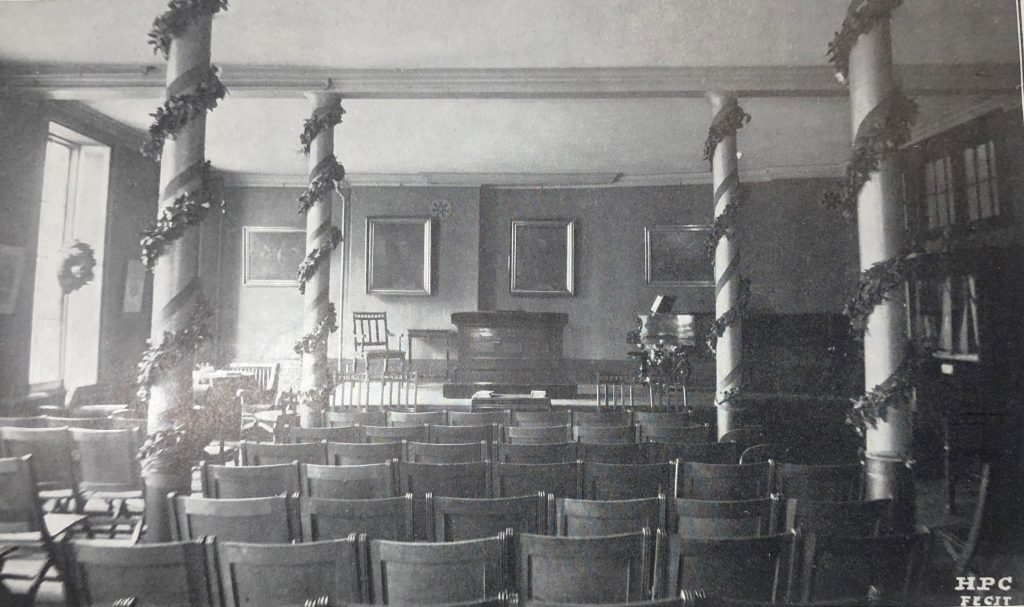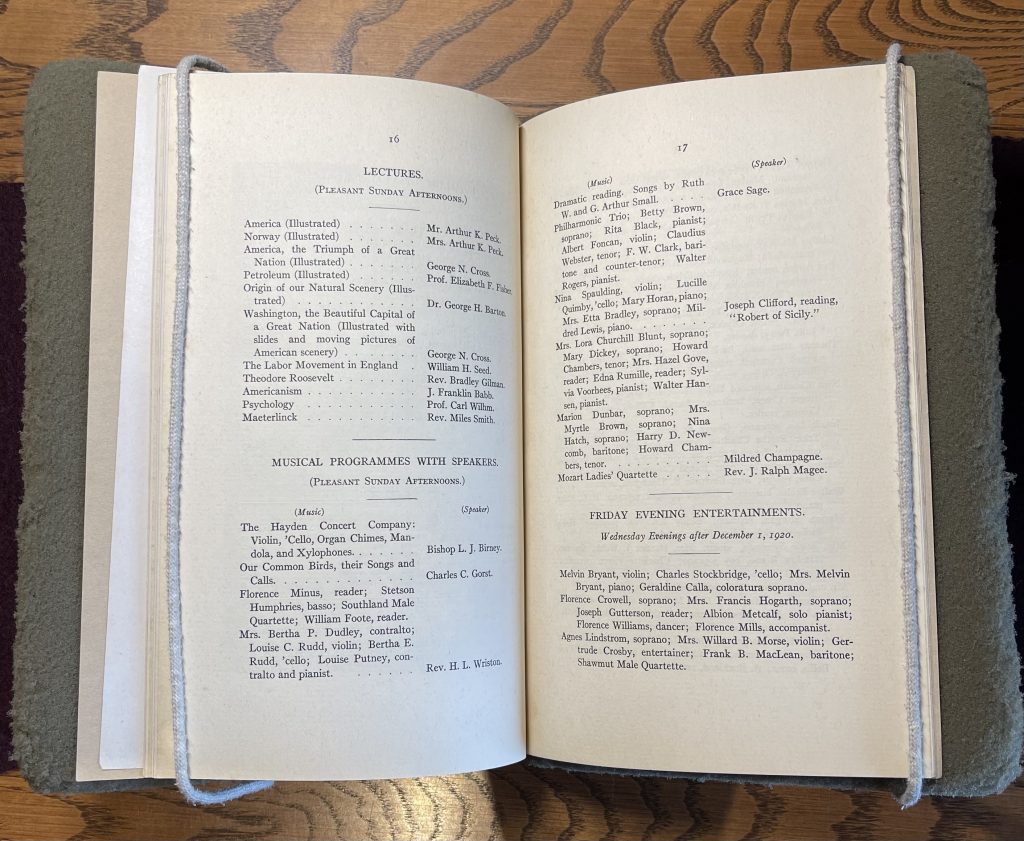By Dr. Kristof Loockx, Centre for Urban History, University of Antwerp
On a Sunday afternoon in 1920, the Boston Port and Seamen’s Aid Society invited Professor Elizabeth F. Fisher (1873-1941) to deliver an illustrated lecture on petroleum at the Mariner’s House on 11 North Square.[1] Born in Boston, Fisher was a renowned scientist who graduated from MIT and held a permanent position as Professor of Geology and Mineralogy at Wellesley College. Like many other lecturers of that era, she most likely presented findings from her recent book.[2] In it, she offered educational insights into the geographical distribution of various natural resources, such as oil, and their industrial applications in the US. The book featured a rich variety of illustrations, such as geological maps and images of industrial uses of petroleum, that were likely used at the time of her lecture.[3] The seamen’s society had acquired a stereopticon in 1894, which marked a significant change in the programming of the organization’s lecture and entertainment series, as it enabled presenters to enrich their talks with illustrated projections on a wall.[4]

My research at the MHS explores a relatively uncharted aspect of maritime history: the role of seamen’s societies in organizing educational and entertainment events to impact the lives of transient seamen. This focus aims to illuminate the broader implications of such organizations beyond merely providing room and board. Organizations like the Boston Port and Seamen’s Aid Society increasingly engaged in promoting cultural programs to foster education, community, and self-improvement, which was part of a broader strategy to instill Christian values and counteract the exploitation of seafarers while ashore. These efforts also addressed the presumed relationship between industrialization and the deterioration of seamanship by re-educating those marginalized by capitalism.[5]
By exploring the rich archival records of the Boston Port and Seamen’s Aid Society at the MHS, I aim to reveal the nuances of how lectures and entertainment events were planned, executed, and received by their intended audiences. This research will provide a more comprehensive picture of the seafarer’s urban and social world, which is all too often reduced to prostitution, gambling, and drinking.[6] The study also demonstrates that seamen’s organizations were an integral part of the broader, flourishing lecture and entertainment circuit in the late 19th and early 20th centuries, echoing the principles of the lyceum movement, which was instrumental in promoting adult education through public lectures, debates, and concerts.[7] Furthermore, the prominent role of figures like Elizabeth F. Fisher highlights the integral part women played in these educational endeavors, as was the case for women who led concerts, delivering musical performances that enriched these gatherings.

While not all lectures, entertainments, and religious gatherings were illustrated, the incorporation of technology like the stereopticon, as well as the employment of instruments during performances, and the later use of the film projector for the showing of silent films –often accompanied by live music– aligned with the broader lecture circuit’s embrace of innovative methods to enhance learning and retention, making complex subjects accessible and engaging to a wide audience.[8] Additionally, seamen’s organizations also fostered a sense of camaraderie and joy through singing religious hymns and singalongs, with the latter often accompanied by the projection of song names to facilitate participation.[9] This use of projection technology highlights seamen’s societies’ aims to blend education with essential social interaction.
The enduring legacy of the Boston Port and Seamen’s Aid Society’s commitment to the welfare and education of seafarers remains a testament to the enduring value of community and knowledge. The rich archival material at the MHS not only sheds light on a neglected facet of maritime history but also underscores the timeless relevance of educational outreach in empowering individuals against the challenges of their times. By delving into the past, we gain insights into the methods and motivations that shaped lives, offering lessons that remain profoundly applicable in today’s ever-evolving societal landscapes.
Link to Multimedia Resources
To give readers a taste of the atmosphere during entertainments at seamen’s organizations like the Boston Port and Seamen’s Aid Society, links to a typical song and film from this era, enjoyed during the singalongs and screenings of silent films, are included below. These examples not only reflect historical tastes but also enrich our understanding of seafarers’ social lives during the period.
Music: I Just Roll Along Having My Ups and Downs (1928)
Film: Hold ‘em Yale (1928)
[1] Boston Port and Seamen’s Aid Society records (BPSAS), MHS, Annual Reports, 1832-1977, Report of the Managers, 1921, 16.
[2] Robert R. Shrock, Geology at MIT, 1865-1965: A History of the First Hundred (Cambridge: MIT Press, 1977), 400.
[3] Elizabeth F. Fisher, Resources and Industries of the United States (Ginn and Co: New York, 1919).
[4] BPSAS, MHS, Annual Reports, 1832-1977, Annual Report of the Managers, 1895, 7.
[5] For a general overview of the Boston Port and Seamen’s Aid Society’s history, see: Patrick M. Leehey, A History of the Mariner’s House (Boston: Boston Port and Seamen’s Aid Society, 1995).
[6] The Boston Port and Seamen’s Aid Society records at the MHS consist of 69 volumes and other records in 17 record cartons (Ms. N-366) and 3 reels of microfilm (P-717), spanning the years 1829-1977.
[7] For the lyceum movement, see, for instance: Tom F. Wright (ed.), The Cosmopolitan Lyceum: Lecture Culture and the Globe in Nineteenth-Century America (Amherst: University of Massachusetts Press, 2014).
[8] Margo Buelens-Terryn and Kristof Loockx, ‘Bringing the World into View: Explorations and the Illustrated Lecture Circuit in Early Twentieth-Century Antwerp and Brussels,’ in: J. Happel, M. Hussinger, and H. Raupach (eds.), Expeditions in the Long Nineteenth Century: Discovering, Surveying, and Ordering (New York: Routledge, 2024), 244-245.
[9] Seamen’s Church Institute’s Digital Archives, Outreach Text and Images, Song-Hit Slides.

